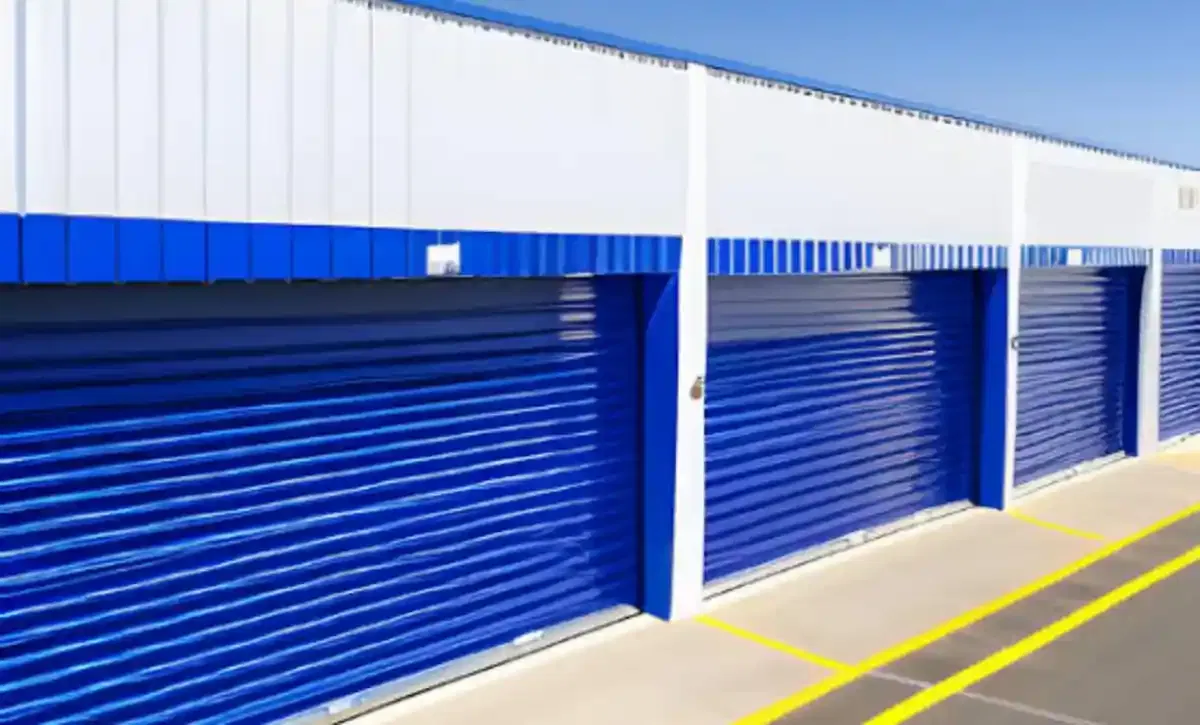If you find yourself with some extra room you’re not currently using, like a garage, you could transform it and start a storage unit business without money. All you need to do is section it into individual spaces using 2x4s, plywood, doors, and padlocks, and voila, you have your mini storage units ready for renting out.
This will require parking your car on the street, but it’s a small price to pay to venture into the storage industry. Alternatively, you could consider acquiring some farmland or a small piece of land in the countryside. Here, you could house a few inexpensive, worn-out sea containers or shipping containers. They could serve as storage units that are easy to set up and cost-effective.
The goal is to keep your initial costs as low as possible, in order to build a customer base that comes back time and again. You could start small, with just a couple of containers, and then gradually increase your capacity as your earnings grow.
While there are numerous ways to keep costs down, you don’t want to compromise on getting insurance coverage for your storage business. The risk of a single lawsuit can turn your affordable venture into a burdensome investment. So, these are just the basics – now, let’s get into the real deal.
- Unused spaces like garages can be transformed into mini storage units to start a business without initial investment.
- Acquiring inexpensive sea containers on small pieces of land can serve as cost-effective storage units.
- Insurance coverage is crucial to protect your storage business from potential lawsuits.
- Key steps to start include developing a business plan, selecting a location, obtaining licenses, and building partnerships.
- Profitability hinges on operational efficiency, minimizing costs, and maintaining high occupancy rates.
How to Start a Storage Unit Business Without Money
We have been tutoring people for many years on, generally, how to build successful startups that quickly churn in 6 figures yearly. And this is just one of the profitable ventures – even if you want to run it as a side hustle or a full business model. Without further stories, follow these steps to start a storage unit business without money – and still – rack in all the $$$.
1. Develop Your Business Plan
The first thing is a “business plan”. You should create one comprehensive business plan for this business – it is the roadmap you really need since you have no money.
This should detail what your storage unit business will look like, who your customers will be, and how you plan to make money. Your business plan should also include information about the competition and what makes your business unique.
Start by identifying your target market and the needs your business will fulfill. Consider the services you’ll provide, the prices you’ll charge, and how you’ll market your business.
Most starters do not understand that a clear vision of your business from the start can help guide your decisions as you move forward.
| Action | |
|---|---|
| Identify target market | Who will use your storage units? Individuals, businesses, students? |
| Define services | What types of storage units will you offer? Different sizes? Climate-controlled? |
| Set pricing | How much will you charge for each unit? How does this compare to competitors? |
| Plan marketing | How will you attract customers? Online ads? Print? Referrals? |
2. Location Selection for Your Storage Business
You also need the right location for your storage business is vital. Consider a place with high traffic, preferably near a major intersection, surrounded by residential and commercial establishments.
However, keep an eye on the competition. If there are many established self-storage firms in the area, it might be worthwhile to consider a different location. We’ve tabulated these few actions:
| Action | |
|---|---|
| Scout for location | Find a high-traffic area, near a major intersection, with residential and commercial establishments. |
| Check competition | If the area is already saturated with self-storage businesses, consider a different location. |
The demographics of the area, like the target customers’ age group and median income, can provide a reasonable estimate of the business potential. Areas with a higher number of young people living in rental properties can be a better choice over upscale neighborhoods, as individuals in lower-income brackets, living in smaller rental apartments, are more likely to need extra storage space.
| Action | |
|---|---|
| Study demographics | Understand the age group, income levels, and housing status of the local population. |
| Target lower-income areas | People living in small rental apartments often need additional storage space. |
You also want to look at the business visibility and accessibility. Ensure your business is easy to spot and access. Your signage should be visible, and there should be ample parking. The location should also be near roads for quick access.
| Action | |
|---|---|
| Ensure visibility | Your signage should be easily seen from the street. |
| Check for accessibility | There should be ample parking and easy road access. |
3. Obtain Licenses and Permits
Before starting your self-storage unit business, ensure you have all the required permits and licenses. Don’t fail to obtain the correct documentation to avoid closure or financial penalties.
This typically includes a certificate of occupancy, a small business permit, service contracts, and other legal paperwork. Research the prerequisites you need for your location and prepare them before launching your business.
| Action | |
|---|---|
| Research legal requirements | Find out what permits, licenses, and registrations are required in your area. |
| Obtain permits and licenses | Secure all the necessary documents before opening your business. |
4. Build Partnerships
Remember, the context of our discussion is to start a storage unit business without money. So, let’s focus on those funding sources that could make a difference.
Start by identifying potential partners who could provide the physical space for your storage units, such as real estate owners with idle land or buildings. Approach these individuals or companies with a proposal outlining how they could benefit from partnering with you.
Remember to communicate clearly the benefits of the partnership, like shared profits, and be open to negotiations.
| Action | |
|---|---|
| Identify potential partners | Look for individuals or companies with unused property that could be converted into storage units. |
| Develop proposal | Create a plan outlining how the partnership would work and the benefits for both parties. |
| Approach potential partners | Reach out to potential partners, present your proposal, and negotiate terms. |
5. Seek Funding
There are several ways you can fund your storage unit business without using your own money. One is through crowdfunding, where you ask a large number of people to contribute a small amount of money to your business.
You’d need a compelling pitch and set up a campaign on a crowdfunding platform. You can also apply for grants or low-interest loans designed for small businesses.
| Action | |
|---|---|
| Crowdfunding | Set up a campaign on a crowdfunding platform, prepare a compelling pitch, and share your campaign widely. |
| Grants and loans | Research and apply for grants or loans suitable for your business. Be prepared to provide your detailed business plan. |
6. Lease Instead of Buy
Leasing can be a cost-effective way to get the equipment you need without a large upfront investment. This comes in if you don’t have all the money to buy land or property for your storage business. Moreover, leasing will help you test if the business is worth it in the specific location – and if it’s not – it’s easier to pull out.
Reach out to leasing companies to see what options are available. Make sure to negotiate the terms to get the best deal and ensure the lease agreement is clear and fair.
| Action | |
|---|---|
| Identify equipment needs | List the equipment you need for your business, such as moving trucks, forklifts, or security systems. |
| Contact leasing companies | Research and contact leasing companies. Compare their offerings and prices. |
| Negotiate lease | Get the best deal by negotiating the terms of the lease. Be sure you understand all terms and conditions before signing. |
7. Consider Bartering Systems
Bartering is a way to exchange services without money. You can offer your storage services to other businesses in exchange for the services you need. For example, a marketing agency might help you with advertising in exchange for using your storage units. It’s a win-win situation where both parties get what they need without spending cash.
| Action | |
|---|---|
| Identify needs | What services do you need that could be bartered? Marketing? Legal advice? Construction? |
| Find barter partners | Look for businesses that need storage services and offer the services you need. |
| Negotiate barter deals | Propose a barter deal. Make sure both parties are clear on what they’re offering and receiving. |
8. Register Your Business
Having established your funding sources (since you have no money), decide on a business name to register for your storage unit business. This process varies depending on your location, but it generally involves filing the appropriate paperwork with your local or national government and paying a fee.
Business registration will legitimize your business, allowing you to conduct operations under your business name.
Moreover, you should also decide on the legal structure of your business, such as sole proprietorship, partnership, LLC, or corporation, as this can affect your taxes and liability.
Let’s break these into actions:
| Action | |
|---|---|
| Choose business name | Make sure the name is unique and reflects your business. |
| Register your storage business | File the necessary paperwork with the appropriate government body and pay the registration fee. |
| Decide the business structure | Consider if you want to operate as a sole proprietorship, partnership, LLC, or corporation. Consult with a lawyer or accountant if needed. |
9. Obtain Necessary Permits and Licenses
Depending on your local laws and regulations, you may need specific permits or licenses to operate a storage unit business. Permits and licenses may include zoning permits, building permits, or business licenses.
Check with your local government or a legal advisor to determine what permits and licenses are necessary, and be sure to factor these costs into your business plan.
| Action | |
|---|---|
| Research local regulations | Understand the local laws and regulations that pertain to starting a storage unit business. |
| Obtain permits & licenses | Apply for and obtain the necessary permits and licenses before you start operations. |
10. Set Up Your Accounting System
For someone whose plan is to start a storage unit business without money, you would importantly have to set up an effective accounting system. You need this to manage your finances and stay on top of your tax obligations.
You can use accounting software or hire an accountant to help you. Your accounting system should help you track income and expenses, handle invoicing, and prepare financial reports.
| Action | |
|---|---|
| Choose accounting method | Will you use software, hire an accountant, or both? |
| Set up a reliable accounting system | Get your system in place, learn how to use it, or train your accountant on your business procedures. |
| Manage finances | Regularly update and check your financial records. |
11. Insure Your Business
During the introduction of this guide, we mentioned how important business insurance can be, especially for a storage business. You don’t want to risk operating the business without one.
Insurance can obviously protect your business from potential liabilities and losses. You’ll want to consider different types of insurance such as property insurance, liability insurance, and workers’ compensation insurance if you have employees. An insurance agent can provide advice on the types of coverage that would be most suitable for your business.
| Action | |
|---|---|
| Consult an insurance agent | Find a reputable agent who can explain your insurance options. |
| Choose insurance policies | Select the insurance types that best fit your business needs and risks. |
| Buy insurance | Purchase your chosen insurance policies before starting operations. |
12. Create a Marketing Plan
Your marketing plan is your roadmap to attracting and retaining customers. It should detail how you plan to get your business in front of potential customers, which could be through online advertising, print media, referrals, or other methods.
The marketing plan should be tailored to your target audience and highlight what sets your storage unit business apart.
| Action | |
|---|---|
| Identify target customers | Who are your ideal customers and where can you find them? |
| Define marketing channels | Will you use online advertising, direct mail, local advertising, social media, or other channels? |
| Create marketing plan | Outline your strategies for each channel and how you’ll measure success. |
13. Get the Storage Business to Start Making Money
With all the groundwork done, you’re ready to officially launch your business. This includes opening your doors for business, implementing your marketing strategies, and beginning to accept customers.
Prioritize providing excellent customer service to encourage repeat business and referrals – they can be invaluable for growing your business.
| Action | |
|---|---|
| Launch operations | Open your storage units for business and ensure all systems (e.g., security, payment, customer service) are functioning properly. |
| Implement marketing plan | Begin executing your marketing strategies to attract customers. |
| Deliver excellent service | Provide high-quality service to retain customers and generate positive word-of-mouth. |
Just so we don’t forget, security is a must factor in a storage unit business. In fact, it is one of the critical considerations in the cons and pros of owning a storage business. So, you have to invest in a reliable security system to help protect stored items. It does not have to be an expensive system.
Other Ways to Source Funds for a Storage Business with No Money
The focus remains “start a storage unit business without money” – we know this. You will notice that half of these methods were mentioned initially, but we have improved and added more you will need to get your storage unit business running on a solid foundation. And here are some other ways to raise funds for this business if you have little or none.
1. Partnerships & Collaborations
Collaborate with other businesses or find a partner to reduce your upfront costs of starting a storage unit business.
You may find someone who owns the unused property and is willing to convert it into a storage facility in exchange for a share of the profits. This can be a win-win situation as the partner gets to monetize their idle asset, while you get to launch your business without a significant capital outlay. Make sure there are legal agreements in place to avoid future disputes.
2. Crowdfunding
Crowdfunding can help raise funds from a large number of people, typically via the Internet. You just have to pitch your business idea on platforms like Kickstarter, GoFundMe, or Indiegogo.
Ensure a compelling story that resonates with potential contributors. You should also provide a clear breakdown of how the funds will be used and offer rewards to backers such as discounted services once your business is up and running.
3. Leasing Equipment
How about leasing? Buying equipment and property outright can be expensive. A good alternative is leasing. It will allow you to get the necessary equipment like moving trucks, forklifts, security systems, etc., for your business without a significant upfront cost. However, remember that you will need to make monthly payments, so factor that into your financial planning.
4. Grants and Small Business Loans
There are various grants and small business loans available for entrepreneurs. The government often offers assistance to start-ups, and there are also private institutions that provide financial help.
While these do have to be paid back over time, the interest rates are typically lower than traditional loans. Keep in mind that you’ll need a solid business plan to qualify.
5. Bartering Services
This is an old but effective method of getting what you need without cash. You could offer your storage services to other businesses in exchange for what they can offer, such as marketing services, legal advice, or construction work. This can greatly reduce your startup costs and create mutually beneficial relationships.
6. Find Volunteers or Unpaid Internships
For a start, work with volunteers and unpaid interns. But discuss this with the applicants, as well as the knowledge they stand to gain from the business.
7. Startup Incubators and Accelerators
These are programs or organizations that help startups in their early stages. They provide services such as training, mentorship, and sometimes funding. It can significantly reduce costs, learn quickly, and potentially attract investors. Search for local programs or industry-specific ones that could help your storage unit business.
8. Bootstrapping
Bootstrapping involves building your business from the ground up with your personal savings and the cash flow from the business itself. This is the most cost-effective and least risky way to start a business. However, it requires careful financial planning and potentially making personal sacrifices in terms of time, lifestyle, and disposable income.
9. Seeking Angel Investors
You can look for angel investors who will provide capital for your storage unit business in exchange for ownership equity or convertible debt. They will typically provide you with much-needed funds and sometimes bring valuable business acumen and connections. Usually, you’ll need a solid business plan and a persuasive pitch to attract angel investors.
Where is the Best Place to Build a Storage Facility?
The best place to build a storage facility primarily depends on (1) demand and (2) accessibility.
High-demand areas are often the best places to construct storage facilities. These are typically found in locations experiencing rapid growth, such as suburban areas with new housing developments or city regions experiencing urban revitalization. For example, places where many people are moving to and need temporary storage for their belongings. These areas often lack the necessary storage space, creating a potential market for your storage facility.
| Demand factors | |
|---|---|
| Population growth | Places experiencing a surge in population typically require more storage. |
| Housing developments | New housing developments often indicate a need for additional storage. |
| Urban revitalization | Cities undergoing urban renewal often result in residents needing temporary storage. |
On the other hand, the facility must also be easily accessible. Locations near major roads or highways are often the best choices, as they offer easy access for potential customers. Moreover, it’s beneficial to place your facility near residential or commercial areas, where a large number of potential customers reside or work.
| Factors | |
|---|---|
| Major roads/highways | Locations near major transport routes allow easy access for customers. |
| Residential areas | Storage facilities located close to homes are convenient for residents. |
| Commercial areas | Businesses often require storage, making these areas suitable. |
How Profitable is a Storage Unit Business?
Storage unit businesses can be quite profitable but this depends on the business location, demand, and operational efficiency.
You can evaluate the profitability by considering the cost of investment, operational expenses, and potential revenue. Usually, experts maximize profits by locating their business facility in an area with high demand and easy access, as mentioned earlier.
| Factors | |
|---|---|
| Cost of investment | This includes land acquisition, construction costs, and equipment purchases. |
| Operational expenses | These are recurring costs like utilities, staff salaries, and maintenance. |
| Potential revenue | This depends on demand, rental prices, and facility occupancy rates. |
However, the key to making a storage unit business profitable lies in operational efficiency. This includes minimizing operational costs by ensuring the facility is energy-efficient and effectively managed. A well-run storage unit business can maintain high occupancy rates, leading to a steady stream of revenue.
| Factors | |
|---|---|
| Energy efficiency | Lower utility costs can be achieved through energy-efficient designs and technologies. |
| Effective management | Good management ensures high occupancy and customer satisfaction. |
How Much Net Profit Does a Storage Owner Make?
A self-storage business “can be” lucrative, though the amount of net profit a storage owner makes will depend on a multitude of factors such as the location, size, and amenities of the facility, as well as the state of the economy. Consider a medium-sized storage facility with around 100 units. The average monthly rent for a unit can vary widely, but let’s assume $100 per month. That gives $10,000 in revenue each month or $120,000 per year.
| Revenue | |
|---|---|
| Monthly Revenue (100 units @ $100) | $10,000 |
| Annual Revenue | $120,000 |
Then, there are costs to consider. Operating costs, including utilities, staff salaries, security, maintenance, and marketing, might amount to around 30% of revenue. So, in our example, that’s $36,000 per year.
| Operating Costs | |
|---|---|
| Percentage of Revenue | 30% |
| Annual Costs | $36,000 |
Subtracting costs from revenue gives us a pre-tax profit of $84,000. With a tax rate of, say, 25%, that leaves a net profit of $63,000 per year.
| Profit | |
|---|---|
| Pre-tax Profit | $84,000 |
| Tax (25%) | $21,000 |
| Net Profit | $63,000 |
This example is simplified and your mileage may vary. But it indicates how profitable a storage business can be.
What is the Demand for Self-storage?
The demand for self-storage has been consistently high and even growing over the past decade, driven by various societal and economic factors.
One key factor is the growing trend towards urbanization and downsizing, which means people have less space at home and therefore need extra space to store their belongings.
The industry’s occupancy rates were around 92%, an increase of around 2% since 2015 – the Matthews.
| Year | Occupancy Rate |
|---|---|
| 2021 | 90.5% |
| 2022 | 92.5% |
This indicates a strong demand. Other factors that contribute to this high demand include a strong housing market, as people often need storage when moving. There’s also an increased demand from businesses, particularly e-commerce, which often need storage for inventory.
Read also: Some Low Cost Franchises Under 500
Frequently Asked Questions
So, while exploring the topic of starting a storage unit business without money, we have identified these commonly asked questions in the business:
Operating expenses, cover storage space costs, maintenance, and inventory stocking fees.
You can deduct storage unit expenses from your federal taxes if it’s necessary for your business operation.
The 10’x10′ is a popular storage unit size due to its versatility. It’s about 100 square feet, equivalent to half a standard garage, and can easily hold the contents of a two-bedroom apartment along with boxes and totes.
Self-storage, a niche real estate investment, outperforms peers in recessions.
In 2026, the global self-storage market is predicted to reach $64.71 billion, a significant increase from $48.02 billion in 2020. The U.S. held a dominant position in the market, accounting for 90% of the worldwide self-storage inventory in 2018 — Statista.
Investing in self storage can diversify your portfolio and generate passive income. Yet, many lack the knowledge to achieve a high ROI.
Self storage businesses generate passive income and perform well during economic downturns with low risks. The main income source is the net rental income after deducting the mortgage (if any)






